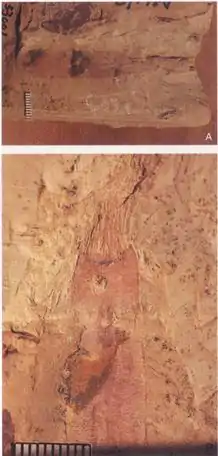Iotuba
Iotuba chengjiangensis (sometimes misspelt Lotuba[2]) is a Cambrian fossil with a U-shaped gut and tentacles, known from the Chengjiang biota. Originally interpreted as a phoronid marine animal, its affinity is currently disputed.[3] It, and the possibly-synonymous taxon Eophoronis, resemble the 'priapulid' Louisella.[4]
| Iotuba | |
|---|---|
 | |
| Type specimen of Iotuba. From [1] | |
| Scientific classification | |
| Kingdom: | Animalia |
| Phylum: | incertae sedis |
| Genus: | †Iotuba |
| Species: | †I. chengjiangensis |
| Binomial name | |
| †Iotuba chengjiangensis Chen et Zhou 1997 [1] | |
References
- Chen, J.-Y.; Zhou, G.-Q. (1997). "Biology of the Chengjiang Fauna". Bull. Natl. Museum Nat. Sci. 10: 11–105.
- Ma, Xiaoya; Hou, Xianguang; Baines, David (2010). "Phylogeny and evolutionary significance of vermiform animals from the Early Cambrian Chengjiang Lagerstätte". Science China Earth Sciences. 53 (12): 1774–1783. doi:10.1007/s11430-010-4084-y.
- DY Huang; J Vannier; JY Chen (2004). "Anatomy and lifestyles of Early Cambrian priapulid worms exemplified by Corynetis and Anningvermis from the Maotianshan Shale (SW China)". Lethaia. 37: 21–33. doi:10.1080/00241160410005088.
- Conway Morris, S. (2006). "Darwin's dilemma: the realities of the Cambrian 'explosion'". Philosophical Transactions of the Royal Society B: Biological Sciences. 361 (1470): 1069–1083. doi:10.1098/rstb.2006.1846. PMC 1578734. PMID 16754615.

This article is issued from Wikipedia. The text is licensed under Creative Commons - Attribution - Sharealike. Additional terms may apply for the media files.